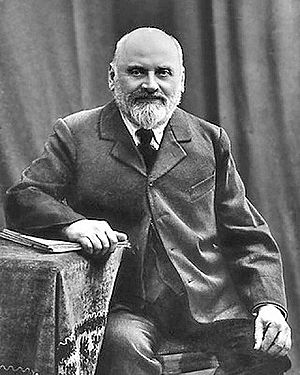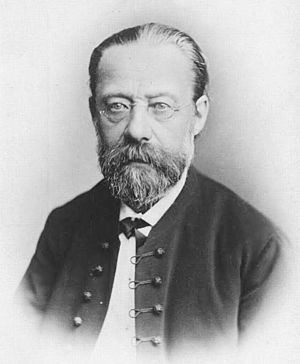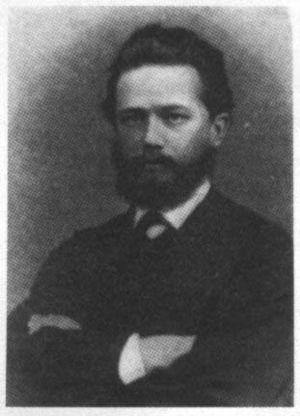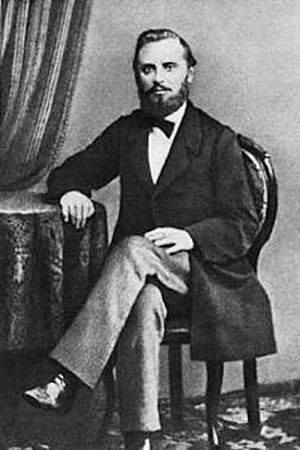Mily Balakirev facts for kids
Quick facts for kids
Mily Balakirev
|
|
|---|---|

Portrait of Balakirev, c. 1900
|
|
| Born | 2 January 1837 [O.S. 21 December 1836] |
| Died | 29 May [O.S. 16 May] 1910) (aged 73) |
| Occupation |
|
|
Works
|
List of compositions |
Mily Alexeyevich Balakirev (UK: /bəˈlækɪrɛv, -ˈlɑːk-/ BƏ-la(h)k-I-rev, US: /ˌbɑːlɑːˈkɪərɛf/ BAH-lah-KEER-ef; Russian: Милий Алексеевич Балакирев, pronounced [ˈmʲilʲɪj ɐlʲɪkˈsʲe(j)ɪvʲɪdʑ bɐˈlakʲɪrʲɪf]; 2 January 1837 [O.S. 21 December 1836] – 29 May [O.S. 16 May] 1910) was a Russian composer, pianist, and conductor. He is known for helping to create a unique Russian style of music. He also encouraged other famous Russian composers, like Pyotr Ilyich Tchaikovsky.
Balakirev started his career by mixing traditional folk music with new classical music ideas. This approach was first explored by composer Mikhail Glinka. Balakirev developed musical patterns that showed strong national pride. After a difficult period, he returned to music. However, he did not have the same level of influence as before.
In the late 1850s, Balakirev worked with critic Vladimir Stasov. Together, they formed a group of composers known as The Five. The other members were Alexander Borodin, César Cui, Modest Mussorgsky, and Nikolai Rimsky-Korsakov. For many years, Balakirev was the only professional musician in the group. He shared his musical ideas with them and encouraged their work. His guidance helped these composers create important pieces. He also helped Tchaikovsky with his famous works, Romeo and Juliet and the Manfred Symphony.
As a composer, Balakirev often took many years to finish his major works. For example, he started his First Symphony in 1864 but finished it in 1897. One exception was his exciting piano piece Islamey. He composed it quickly, and it is still popular among virtuoso pianists today. Many musical ideas often linked to Rimsky-Korsakov or Borodin actually came from Balakirev's early pieces. However, his slow pace in finishing works meant he didn't always get credit for his new ideas.
Life and Music
Early Years and Education
Mily Balakirev was born in Nizhny Novgorod, Russia, into a noble family. His mother, Elizaveta Ivanovna, taught him piano from age four. When he was ten, she took him to Moscow for piano lessons. Sadly, his mother died in 1847 when he was just ten years old.
Balakirev attended school in Nizhny Novgorod. His musical talent was noticed by Alexander Ulybyshev, a leading music figure in the city. Ulybyshev had a large music library and wrote books about composers like Wolfgang Amadeus Mozart and Ludwig van Beethoven.
Balakirev's music teacher was Karl Eisrach. Through Eisrach and Ulybyshev, Balakirev learned a lot about music. He played and listened to works by Frédéric Chopin and Mikhail Glinka. He even got to practice conducting Ulybyshev's private orchestra. By age 14, he conducted Mozart's Requiem. At 15, he led rehearsals for Beethoven's symphonies. His first compositions date from this time.
In 1853, Balakirev started studying mathematics at the University of Kazan. He earned money by teaching piano. During holidays, he continued to play music at Ulybyshev's estate. He wrote a piano fantasy based on Glinka's opera A Life for the Tsar and started his First Piano Concerto.
Meeting Glinka and Early Career
In 1855, Ulybyshev took Balakirev to Saint Petersburg, where he met the famous composer Glinka. Glinka saw Balakirev's talent and encouraged him to pursue music. Balakirev made his public debut in 1856, playing part of his First Piano Concerto. He also had 12 songs published in 1859. Despite his talent, he was very poor and supported himself by giving many piano lessons.
Forming The Five

After Glinka's death in 1857, Balakirev was inspired to create a unique Russian style of music. He believed Russian music should be free from Western European influences. In 1856, he began meeting other musicians who shared his ideas. He gathered composers like Modest Mussorgsky (1858), Nikolai Rimsky-Korsakov (1861), and Alexander Borodin (1862). Along with César Cui, these men were called "a mighty handful" by critic Vladimir Stasov. They became known as The Five.
Balakirev had more musical experience than the others in The Five. He taught them by exploring how other composers created their works. He believed it was best to start composing right away and learn through practice. However, he was very strict and wanted his students' musical tastes to be exactly like his own. He would often change parts of their compositions to sound more like his music.
By the late 1860s, Mussorgsky and Rimsky-Korsakov began to disagree with Balakirev's strong control. The other members of The Five also became interested in writing operas, which Balakirev did not highly value.
Free School of Music
During this time, new music schools were opening in Russia. Balakirev strongly disagreed with the traditional teaching methods of these schools. He believed they copied German styles too much and limited a composer's creativity.
To offer a different approach, Balakirev and Gavriil Lomakin founded the Free School of Music in 1862. This school offered music education for free. It also focused on singing, especially choral music, which was important for the Russian Orthodox Church. Balakirev conducted orchestral concerts to raise money for the school. These concerts featured music by composers like Hector Berlioz, Robert Schumann, Franz Liszt, and the first works of The Five.
Important Works and Travels
In 1862, Balakirev visited the Caucasus region. He was so inspired that he returned in later years. He collected folk tunes from this area, which greatly influenced his music. One of his first pieces to show this influence was his setting of Alexander Pushkin's "Georgian song."
In 1866, Balakirev's Collection of Russian Folksongs was published. These arrangements showed his deep understanding of Russian folk music. He also began his Symphony in C major, but it took him decades to finish. He started a second piano concerto in 1861 but set it aside for 50 years. He sometimes felt very sad and thought about destroying his music.
Despite these challenges, he could still compose quickly. He started his famous piano piece Islamey in August 1869 and finished it a month later. Nikolai Rubinstein performed this "oriental fantasy" for the first time in December.

Balakirev also helped prepare Glinka's works for publication. In 1866, he traveled to Prague to help with the production of Glinka's operas. He had many disagreements with the Czech conductor Bedřich Smetana over how the operas were performed. Balakirev was very particular about the music's speed, the singers, and even the costumes. Despite the arguments, the operas were successful.
During this visit, Balakirev started an Overture on Czech Themes. This work was performed at a Free School concert in 1867. It was at this concert that Vladimir Stasov first used the phrase "Mighty Handful" to describe The Five.
Balakirev encouraged Rimsky-Korsakov and Borodin to finish their first symphonies. He conducted their first performances in 1865 and 1869. He also conducted early performances of Mussorgsky's The Destruction of Sennacherib and the Polonaise from Boris Godunov.
Later Years and Return to Music
In 1867, Balakirev was asked to lead the Russian Musical Society concerts. However, his strong opinions caused problems, and he was dismissed in 1869.

After his dismissal, Pyotr Ilyich Tchaikovsky wrote an article defending Balakirev. Balakirev had conducted Tchaikovsky's music before, and Tchaikovsky had dedicated his symphonic poem Fatum to Balakirev. This led to a friendship and a creative partnership. Balakirev helped Tchaikovsky create his masterpiece, the fantasy-overture Romeo and Juliet.
Later, in 1880, Balakirev suggested that Tchaikovsky compose a symphony based on Lord Byron's poem Manfred. Tchaikovsky eventually agreed, and the Manfred Symphony, finished in 1885, became one of Tchaikovsky's largest works. Tchaikovsky dedicated this symphony to Balakirev as well.
In 1868, Balakirev became the director of the Free Music School. He worked to attract popular musicians to perform there. However, the school faced financial problems. In 1871, Balakirev experienced a difficult period and took a five-year break from music. He withdrew from his friends and stopped composing. He finally resigned from the Free Music School in 1874. To earn money, he became a railway clerk in 1872.
In 1876, Balakirev slowly returned to the music world, though with less intensity. He began composing his symphonic poem Tamara. He also started helping to edit Glinka's works again.
In 1881, he became the director of the Free School of Music once more. In 1882, he finished Tamara. In 1883, he was appointed director of the Imperial Chapel, a position he held until 1895. After retiring, he focused on composing. Between 1895 and 1910, he completed two symphonies, a piano sonata, and parts of his Second Piano Concerto.
Balakirev died on May 29, 1910, and was buried in Tikhvin Cemetery in Saint Petersburg.
Balakirev's Music
Balakirev was very important in the history of Russian music. He helped shape Russian orchestral music and songs in the late 1800s. He learned from Glinka how to use Russian folk songs in his music. He also developed a clear and bright orchestral style, influenced by Hector Berlioz. Balakirev combined these ideas with the advanced Romantic music styles of his time.
Unfortunately, because he took so long to finish many of his works, Balakirev didn't always get credit for his new ideas. Pieces that would have been very popular in the 1860s and 1870s had less impact when they were released much later. This was because younger composers had already developed similar styles. For example, Rimsky-Korsakov's Scheherazade was influenced by Balakirev's Tamara.
Despite the long time it took to compose, his music, especially his two symphonies, sounded consistent. This suggests that his musical style did not change much over the years.
Musical Influences
Balakirev's early experience as a pianist meant that piano composers greatly influenced his works. He wrote pieces in many styles used by Frédéric Chopin. Another important influence was Franz Liszt, which can be heard in Islamey and his symphonic poem Tamara.
Balakirev's connection to Glinka's music is clear in how he used folk material. Balakirev improved on Glinka's techniques by using small musical ideas, counterpoint, and key changes. This helped him combine classical music with folk songs.
Balakirev also collected and arranged folk songs. This work showed him unique features of Russian folk music, like the Dorian mode and flexible rhythms. He used these features in his compositions.
Even though The Five often opposed German music, Balakirev understood German symphonic style well. This is impressive because he taught himself how to compose. His King Lear overture, written at age 22, showed his understanding of dramatic musical forms, similar to Beethoven's overtures.
Russian Style in Overtures
In his First Overture on Russian Themes, Balakirev focused on creating Russian orchestral works. He used folk songs as his themes. He took Glinka's Kamarinskaya as a model, using a slow song for the introduction and then two fast dance songs. Balakirev's use of two songs in the fast section allowed him to develop the themes more symphonically.
His Second Overture on Russian Themes showed even more skill. Balakirev used Beethoven's method of taking short musical ideas from longer themes. This allowed him to combine these ideas into a rich musical texture. This overture showed how folk songs could be used in large symphonic pieces. It also explored the flexible rhythms and changing keys found in Russian folk songs.
Like other members of The Five, Balakirev believed in program music. This is music inspired by a story, poem, or picture. However, for Balakirev, the musical form was always most important. His overtures were crucial in creating the "Russian" musical style. His style was adopted by his friends and other composers, becoming a national characteristic.
Progressive Development: First Symphony
Balakirev started his First Symphony after his Second Overture. He stopped working on it to focus on other pieces, then returned to it 30 years later. The first movement of this symphony has a very unusual design. It starts with a slow introduction that presents the main musical idea. The main part of the movement then develops this idea in three stages, each becoming more complex. If Balakirev planned this in 1864, it would be an early example of this kind of musical development.
Orientalism: Tamara
Balakirev also developed the "orientalism" found in Glinka's opera Ruslan and Lyudmila. This style appears in his Georgian Song, Islamey, and Tamara. This style has two parts: a slow, flowing melody with decorations, and a faster, more exciting section with quick melodies over slower harmonies. This style helped evoke the mystery of the distant, exotic East.
Tamara is often considered Balakirev's greatest work and a key example of orientalism. He was inspired by the poetry of Mikhail Lermontov about Tamara. The music tells a wide-ranging story with great skill and a satisfying structure.
Images for kids
-
Portrait of (left to right) Balakirev, Vladimir Odoevsky and Mikhail Glinka by Ilya Repin. The painting is somewhat anachronistic – Balakirev is depicted as a man approaching middle age, with a full beard; however, Glinka died in 1857, when Balakirev was only 20 years old.
-
Bedřich Smetana, with whom Balakirev quarreled over the Prague production of Glinka's opera A Life for the Tsar
-
Pyotr Ilyich Tchaikovsky at the time he wrote Romeo and Juliet with Balakirev's support
See also
 In Spanish: Mili Balákirev para niños
In Spanish: Mili Balákirev para niños















